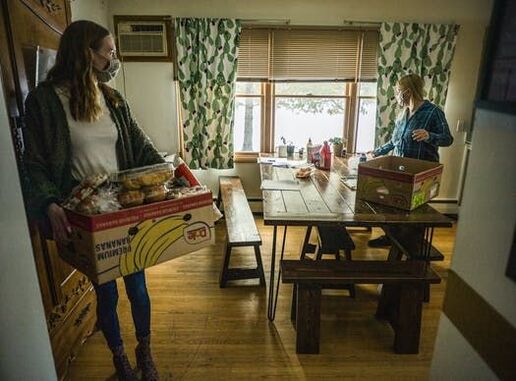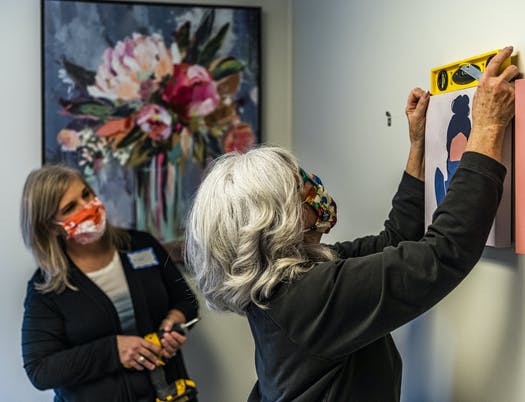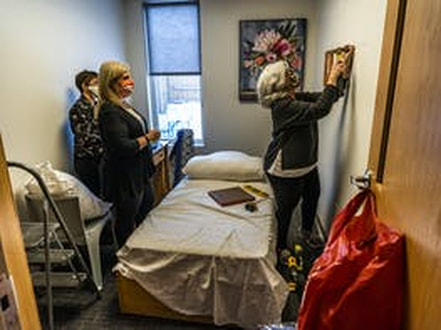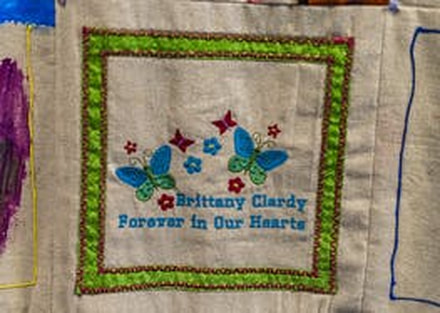|
Volunteer interior designers turn girls' shelter from drab to welcoming for teens escaping sex trafficking. Volunteer interior designers turn Brittany's Place from drab to dreamy to encourage girls to stay awhile. By Katy Read Star Tribune |
photo of brittany's Place re-modeled roooms | |
Star Tribune reports on spike of southwest metro youth seeking shelter at 180 Degrees' Hope House
2/17/2021
COVID may increase youth homelessness across Twin Cities metro
Pressures brought on by COVID may be behind uptick across Twin Cities, suburbs.
By Katy Read Star Tribune
By Katy Read Star Tribune

Photo above: Abigail Botten, left, 180 Degrees Program Manager, helped Youth Advocate Chantra-Lee Jackson get the pantry arranged in the kitchen at Chanhassen’s Hope House.
Photo by: RICHARD TSONG-TAATARII • [email protected]
FEBRUARY 16, 2021 — 12:48PM
Bob and Sue Downs remember many of them vividly.
The boy found huddled in a culvert under a street in downtown Chaska on a 10-below night, body temperature dangerously low. The boy who sneaked into the Chanhassen Dinner Theatres and hid under a stage. The boy who slept under a Chanhassen bridge among "scary dudes" for six weeks after his mother, who struggled with mental illness, kicked him out for eating the last slice of pizza.
"When I speak to teachers, I tell them, 'These kids are in your classroom, and when they leave your classroom they don't go home,' " said Bob Downs, himself a retired middle-school teacher. The teachers' "eyes get wide."
For about 30 years before retiring as foster parents in 2018, the couple hosted hundreds of kids in their big Chaska farmhouse, bearing witness to an oft-hidden reality: Even in affluent suburban communities, teenagers experience homelessness — a problem that family pressures associated with the COVID-19 pandemic may only exacerbate.
Meanwhile, safety nets intended to protect young people — from child protective services to medical and mental health providers to schools — have been less accessible because of the virus.
Places to hang out, like libraries, coffee shops and stores, have been closed.
Homelessness overall, including among youth, was already on the rise before the pandemic, according to Wilder Research, which leads the Minnesota Homeless Study every three years. In 2018, according to an estimate considered conservative, 5,800 kids under 18 had experienced homelessness — 11% more than in 2015.
Problems affecting family members, such as physical or sexual abuse, mental illness, chemical abuse, conflicts over LGBTQ identity, can push kids at all income levels out of their homes.
In Carver County, one of the wealthiest in Minnesota, the rate of homeless youth is similar to other counties in the metro area and the state as a whole.
In 2019's Minnesota Student Survey, 2% of boys and 1% of girls in Carver County reported that they had been on their own staying "in a shelter, somewhere not intended as a place to live, or someone else's home because [they] had no other place to stay" in the past year.
Suburban kids often prefer to stay near jobs, friends and schools rather than seek shelters in downtown Minneapolis. Chanhassen's Hope House — a comfortable house that shelters homeless youth, primarily from the western suburbs — last year took in 120 young people but had to turn away 135.
That's the most ever, which may be due in part to increased awareness of the five-year-old shelter.
But most likely a significant portion "is a direct result of COVID's impact on families," said Dan Pfarr, CEO of 180 Degrees, a St. Paul nonprofit that operates Hope House.
COVID-19 will "exacerbate everything," Bob Downs said.
Amanda Stewart, an emergency-room pediatrician and Harvard Medical School instructor who has researched the pandemic's effects on children, said the combination of kids being home from school and families being stuck in one place can lead to fights that end with kids leaving home or being kicked out.
A July article in Pediatrics, the journal of the American Academy of Pediatrics, said "it is likely that stay-at-home orders, combined with increased economic instability and family pressures, will increase [youths'] risks for harm and, in some cases, may make it untenable [and potentially dangerous] for them to shelter in place."
Schools offer kids respite from troubled families and provide opportunities for staffers to spot signs of abuse, said Fredrick Blocton, chairman of 180 Degrees' board. With schools closed, those problems become invisible.
"School can be a really stabilizing force in young people's lives; taking it out of the equation is going to have a big impact," said Michelle Decker Gerrard of Wilder Research, who directs the Minnesota Homeless Study.
More than 80% of homeless youth Wilder surveyed reported having "adverse childhood experiences," including living with someone who abused substances, parents with mental health issues, being physically or sexually abused or witnessing the abuse of another family member and being neglected.
In October, when the survey was conducted, 22% of homeless youth had spent more than a week outside and 38% spent more than a week "doubled up," or living with someone else temporarily.
The pandemic may reduce opportunities to stay with friends, leaving young people vulnerable to exploitation.
Because they don't usually fit the stereotypical images of the homeless — people sleeping on sidewalks or holding cardboard signs at stoplights — homeless teenagers are often invisible to casual observers, advocates say.
Pat Barry, chief deputy at the Carver County Sheriff's Office, said deputies who see people living in their cars — often near places like convenience stores that are well-lit, open long hours and offer cheap food and access to bathrooms — can offer help finding services.
Homeless youth are tougher to recognize, he said, but members of the public can help.
"I would encourage people to be vigilant and if they see something that just doesn't look right they should call," Barry said. "It's never an inconvenience for us. ... At minimum we've saved some kids."
Katy Read • 612-673-4583
Katy Read is a reporter covering Carver County and western Hennepin County. She has also covered aging, workplace issues and other topics for the Star Tribune. She was previously a reporter at the Times-Picayune in New Orleans, La., and the Duluth News-Tribune.
[email protected] 612-673-4583

**FOR IMMEDIATE RELEASE**
March 3, 2022
St. Paul, Minnesota
180 Degrees has again received the Charities Review Council’s Meets Standards® seal, a visual marker on nonprofit strength. Nonprofit organizations, such as 180 Degrees, earn the Meets Standards® seal by voluntarily participating in Charities Review Council’s Accountability Wizard® review process. The only web-based product of its kind, the Accountability Wizard® is a time-tested tool, elevated by nationally recognized capacity building practitioners and philanthropic thought leaders.
The Accountability Wizard® is based on Charities Review Council’s 25 Accountability Standards®, a
balance of nonprofit sector promising practices, public expectations, and legal requirements,
representing the shared expectations between donors and nonprofits. The review process
examined four key areas: Public Disclosure, Governance, Financial Activity, and Fundraising. As a result, 180 Degrees has aligned its practices, policies and procedures to widely accepted
standards of accountability, leading them to greater strength, efficacy and to the achievement of the
Meets Standards® seal.
"The Charities Review Council's process has helped us to create thoughtful policies which protect our clients and provide greater transparency to donors as well as the general public," says CEO/President Dan Pfarr.
180 Degree‘s full review report is available online at www.smartgivers.org, and the organization will also be listed in Charities Review Council’s bi-annual Smart Giver Newsletter.
FOR MORE INFO: CONTACT: Janet Hallaway [email protected]
March 3, 2022
St. Paul, Minnesota
180 Degrees has again received the Charities Review Council’s Meets Standards® seal, a visual marker on nonprofit strength. Nonprofit organizations, such as 180 Degrees, earn the Meets Standards® seal by voluntarily participating in Charities Review Council’s Accountability Wizard® review process. The only web-based product of its kind, the Accountability Wizard® is a time-tested tool, elevated by nationally recognized capacity building practitioners and philanthropic thought leaders.
The Accountability Wizard® is based on Charities Review Council’s 25 Accountability Standards®, a
balance of nonprofit sector promising practices, public expectations, and legal requirements,
representing the shared expectations between donors and nonprofits. The review process
examined four key areas: Public Disclosure, Governance, Financial Activity, and Fundraising. As a result, 180 Degrees has aligned its practices, policies and procedures to widely accepted
standards of accountability, leading them to greater strength, efficacy and to the achievement of the
Meets Standards® seal.
"The Charities Review Council's process has helped us to create thoughtful policies which protect our clients and provide greater transparency to donors as well as the general public," says CEO/President Dan Pfarr.
180 Degree‘s full review report is available online at www.smartgivers.org, and the organization will also be listed in Charities Review Council’s bi-annual Smart Giver Newsletter.
FOR MORE INFO: CONTACT: Janet Hallaway [email protected]






